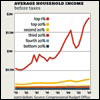Session Overview

|
Up to this point in the course, we have focused only on the outcomes generated by the market and their efficiency properties. Competitive equilibria in a market are typically efficient, but they may not be equitable: Some people may benefit greatly from the market’s operation, while others do not. As a society, we may decide we want to alter these outcomes in a way that seems more equitable, but such changes typically come at the cost of efficiency. In this lecture, we will begin to learn about the efficiency-equity trade-off. How do we feel about differences in income? This lecture explores this question and the efficiency- equity trade-off. Image courtesy of Vince_Lamb on Flickr. |
Keywords: Income distribution; social welfare function; isowelfare curves; Utilitarianism; Raulsian criteria; Nozickian; commodity egalitarianism
Session Activities
Readings
Before watching the Lecture Video, read the course textbook for an introduction to the material covered in this session:
- [R&T] Chapter 19, “Inequality, Poverty, and Discrimination.” Sections 19.1-2.
- [Perloff] Chapter 10, “General Equilibrium and Economic Welfare.” (optional)
Lecture Videos
Resources
Check Yourself
Concept Quiz
This concept quiz covers key vocabulary terms and also tests your intuitive understanding of the material covered in this session. Complete this quiz before moving on to the next session to make sure you understand the concepts required to solve the mathematical and graphical problems that are the basis of this course.
Question 1
Assume that society has a utilitarian social welfare function. Under what condition does maximizing the social welfare function call for an equal distribution of income?
A utilitarian social welfare function calls for an equal distribution of income when individual utility functions are identical. In this case, social welfare is maximized by allocating an equal amount of income to each individual. If preferences are identical, it does not matter what the shape of those preferences are (i.e., if the marginal utility of income varies with income). However, if preferences are not identical, then maximizing a utilitarian social welfare function may entail a very different distribution of income.
Question 2
An income guarantee program uses a government transfer program to guarantee all individuals a certain amount of income. What is one of the potential negative, efficiency-reducing effects of such a program?
If an income guarantee program is implemented, then individuals who might otherwise have worked and earned less than the amount guaranteed by the program will now stop working and rely solely on government transfers for income. This results in a decrease in labor supply, which is efficiency-reducing. There is no impact on labor demand. It is true that the income of the poor increases, but that is not a negative side effect of the policy: it is the goal of the policy.
Further Study
These optional resources are provided for students that wish to explore this topic more fully.
Textbook Study Materials
See the course website for Econ 302, Intermediate Microeconomics taught at Penn State in 2011.










